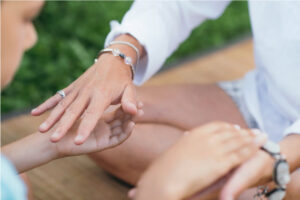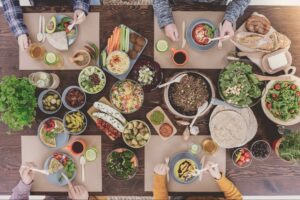Macrobiotics Today, September/October 1994, Vol. 34, No. 5
Macrobiotics in America is still in its infancy. It will take many years to progress through childhood, adolescence, and into adulthood. Like a growing person, macrobiotics will undergo many changes as the years go by.
Over the last thirty years macrobiotics has taken shape and form primarily because of our Japanese-ancestry teachers. In the twenty years since I have started this great adventure called macrobiotics, I have seen and experienced many changes: From the drastic reduction of salt use to the availability of tofu and tempeh, to the development and use of lighter cooking methods and delicious desserts.
In my travels teaching cooking I have experienced different climates and people with different nutritional needs. In the United States we have a wealth of cultural differences and we need to explore them.
The Oriental slant to our cooking and philosophy has been extremely important and I believe it should continue to be, but we need to discover the uses of grains, fermented foods, home remedies and methods of food preparations from all nationalities.
My grandparents came to this country as children – three from Sicily and one from northern Italy. They all remembered the way they ate in there homes in small villages. I was very fortunate to learn from them the Italian cooking of their mothers and grandmothers. It was nothing like the Italian cookbooks popular today which are filled with meat, dairy, and tomatoes.
Most of their dishes were pasta or rice with vegetables and beans. The Sicilians even used some sea vegetables. Very dark, hard breads were baked at home. Very little dairy or meat was used. Fish was eaten occasionally, and chestnuts were often used for deserts. Vegetables were pickled, and fruits and vegetables were dried for winter. Wheat berries were cooked whole and many plants were grown and dried for use as home remedies. Pure olive oil was used often (perhaps this is why I enjoy the taste of olive oil so much).
If each of us could explore the habits of our ancestors, we could add greatly to the variety of foods, cooking styles and remedies we use in a macrobiotic lifestyle. I’m waiting for the day when there are macrobiotic cookbooks from many different countries around the world.
In the United States the climate and geographical conditions vary from Alaska to southern California: including hot dry deserts, open plains, coastal areas, mountain regions, lakes and humid areas. All of these areas have changing seasons, but winter in southern Texas is very different from winter in Maine. Regional standard macrobiotic dietary recommendations and cookbooks need to be developed for subtle differences in each area. People interested in macrobiotics should get together and pool their ideas on what foods, especially vegetables, are available where they live, what proportions and what methods of preparation work well, and publish their experiences and ideas to share with others.
When it comes to lifestyle, what I have learned through my macrobiotic studies has confirmed what I have learned from my experiences. A natural lifestyle that includes: general cleanliness, the use of natural fibers, the presence of plants, an uncluttered home, the avoidance of unnecessary appliances and material possessions, the education of our children primarily coming from the home and family – all are good common sense and do not come from any particular ethnic influence. If someone chooses to eat at a low table and use chop sticks it is because it is more comfortable and suits their preference. It seems to me that our home is very “American” even with the futons and zabutons [seat cushions for sitting on the floor]. These natural, cotton products are popular among people who have never heard of macrobiotics or been influenced by Oriental teachers.
One area of my studies that is very important to my husband and I is that of meditation and chanting. Many of our spiritual practices do come from Oriental teachers, but these same teachers have included chanting, songs, exercises and practices from many different countries and cultures including American Indian songs and chants. The singing of “Row, row, row your boat” certainly can’t be said to have an Oriental influence.
The importance of Oriental Medicine cannot be denied. The numerous colleges of Chinese Medicine and schools of Acupuncture that have been increasing in numbers attest to this. The use of visual diagnosis, moxibustion, shiatsu massage, and palm healing, along with dietary and lifestyle recommendations that follow the same principles have been proven effective, especially when we do not get conceptual to the point of overlooking each persons uniqueness in nationality, lifestyle, and geographical location.
As the value of traditional and Oriental Medicine becoming appreciated and fully recognized in the Western world, we need to continue to widen our scope of understanding by study and experience, including the use of herbal medicine, the study of traditional and modern approaches to health and healing of all nationalities, prayer, breathing techniques, exercise, learning to use our minds, and controlling energy.
Our understanding of yin and yang no matter what terms you use, help us understand ourselves and the world we live in. It gives us an advantage when learning how or why any treatment or practice can be used to increase the quality of life. We should use our understanding of balance when we explore our ancestral ways of diet, lifestyle, and healing as well as the traditional practices of other nationalities.
My twelve-year-old daughter Joanne will be starting seventh grade in September 1994. She will be part of the graduating class from high school of the year 2000. I can remember when 1984 seemed like a long way off and many changes were expected in our lives by then. Now I am hoping that many positive changes will take place in our society by the auspicious year 2000. As Joanne enters adulthood in a new century, I pray that what we have learned from our Japanese/Oriental teachers will be remembered and be an important influence on the future for our children.
End of Article
Author bio-statement: Diane Avoli is a macrobiotic teacher and cooking instructor and is the mother of eight children. She lives with her husband and family in Templeton, Massachusetts.



